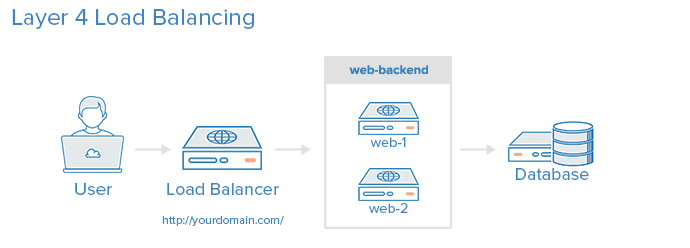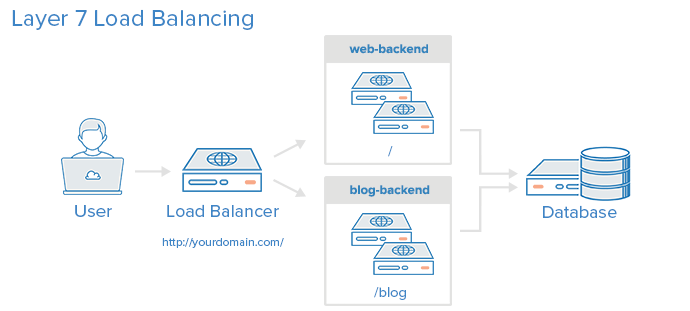HAProxy and Load Balancing Concepts¶
Diese Dokumentation gibt Ihnen
- Überblick über HAProxy
- Basis Load-balancing Terminologie
- Beispiele, wie Sie HAProxy zur Performanceoptimierung einsetzten
Introduction¶
HAProxy, which stands for High Availability Proxy, is a popular open source software TCP/HTTP Load Balancer and proxying solution which can be run on Linux, Solaris, and FreeBSD. Its most common use is to improve the performance and reliability of a server environment by distributing the workload across multiple servers (e.g. web, application, database). It is used in many high-profile environments, including: GitHub, Imgur, Instagram, and Twitter.
HAProxy Terminology¶
There are many terms and concepts that are important when discussing load balancing and proxying. We will go over commonly used terms in the following sub-sections.
Before we get into the basic types of load balancing, we will talk about ACLs, backends, and frontends.
Access Control List (ACL)¶
In relation to load balancing, ACLs are used to test some condition and perform an action (e.g. select a server, or block a request) based on the test result. Use of ACLs allows flexible network traffic forwarding based on a variety of factors like pattern-matching and the number of connections to a backend, for example.
Example of an ACL:
acl url_blog path_beg /blog
This ACL is matched if the path of a user’s request begins with /blog. This would match a request of http://yourdomain.com/blog/blog-entry-1, for example.
For a detailed guide on ACL usage, check out the HAProxy Configuration Manual.
Backend¶
A backend is a set of servers that receives forwarded requests. Backends are defined in the backend section of the HAProxy configuration. In its most basic form, a backend can be defined by:
- which load balance algorithm to use
- a list of servers and ports
A backend can contain one or many servers in it—generally speaking, adding more servers to your backend will increase your potential load capacity by spreading the load over multiple servers. Increase reliability is also achieved through this manner, in case some of your backend servers become unavailable.
Here is an example of a two backend configuration, web-backend and blog-backend with two web servers in each, listening on port 80:
- balance roundrobin line specifies the load balancing algorithm, which is detailed in the Load Balancing Algorithms section.
- mode http specifies that layer 7 proxying will be used, which is explained in Types of Load Balancing section.
The check option at the end of the server directives specifies that health checks should be performed on those backend servers.
Frontend¶
A frontend defines how requests should be forwarded to backends. Frontends are defined in the frontend section of the HAProxy configuration. Their definitions are composed of the following components:
- a set of IP addresses and a port (e.g. 10.1.1.7:80, *:443, etc.)
- ACLs
- use_backend rules, which define which backends to use depending on which ACL conditions are matched, and/or a default_backend rule that handles every other case
A frontend can be configured to various types of network traffic, as explained in the next section.
Types of Load Balancing¶
Now that we have an understanding of the basic components that are used in load balancing, let’s get into the basic types of load balancing.
No Load Balancing¶
A simple web application environment with no load balancing might look like the following:

In this example, the user connects directly to your web server, at yourdomain.com and there is no load balancing. If your single web server goes down, the user will no longer be able to access your web server. Additionally, if many users are trying to access your server simultaneously and it is unable to handle the load, they may have a slow experience or they may not be able to connect at all.
Layer 4 Load Balancing¶
The simplest way to load balance network traffic to multiple servers is to use layer 4 (transport layer) load balancing. Load balancing this way will forward user traffic based on IP range and port (i.e. if a request comes in for http://yourdomain.com/anything, the traffic will be forwarded to the backend that handles all the requests for yourdomain.com on port 80). For more details on layer 4, check out the TCP subsection of our Introduction to Networking.
Here is a diagram of a simple example of layer 4 load balancing:

The user accesses the load balancer, which forwards the user’s request to the web-backend group of backend servers. Whichever backend server is selected will respond directly to the user’s request. Generally, all of the servers in the web-backend should be serving identical content—otherwise the user might receive inconsistent content. Note that both web servers connect to the same database server.
Layer 7 Load Balancing¶
Another, more complex way to load balance network traffic is to use layer 7 (application layer) load balancing. Using layer 7 allows the load balancer to forward requests to different backend servers based on the content of the user’s request. This mode of load balancing allows you to run multiple web application servers under the same domain and port. For more details on layer 7, check out the HTTP subsection of our Introduction to Networking.
Here is a diagram of a simple example of layer 7 load balancing:

In this example, if a user requests yourdomain.com/blog, they are forwarded to the blog backend, which is a set of servers that run a blog application. Other requests are forwarded to web-backend, which might be running another application. Both backends use the same database server, in this example.
A snippet of the example frontend configuration would look like this:
This configures a frontend named http, which handles all incoming traffic on port 80.
- acl url_blog path_beg /blog matches a request if the path of the user’s request begins with /blog.
- use_backend blog-backend if url_blog uses the ACL to proxy the traffic to blog-backend.
- default_backend web-backend specifies that all other traffic will be forwarded to web-backend.
Load Balancing Algorithms¶
The load balancing algorithm that is used determines which server, in a backend, will be selected when load balancing. HAProxy offers several options for algorithms. In addition to the load balancing algorithm, servers can be assigned a weight parameter to manipulate how frequently the server is selected, compared to other servers.
Because HAProxy provides so many load balancing algorithms, we will only describe a few of them here. See the HAProxy Configuration Manual for a complete list of algorithms.
A few of the commonly used algorithms are as follows:
roundrobin¶
Round Robin selects servers in turns. This is the default algorithm.
leastconn¶
Selects the server with the least number of connections—it is recommended for longer sessions. Servers in the same backend are also rotated in a round-robin fashion.
source¶
This selects which server to use based on a hash of the source IP i.e. your user’s IP address. This is one method to ensure that a user will connect to the same server.
Sticky Sessions¶
HAProxy uses health checks to determine if a backend server is available to process requests. This avoids having to manually remove a server from the backend if it becomes unavailable. The default health check is to try to establish a TCP connection to the server i.e. it checks if the backend server is listening on the configured IP address and port.
If a server fails a health check, and therefore is unable to serve requests, it is automatically disabled in the backend i.e. traffic will not be forwarded to it until it becomes healthy again. If all servers in a backend fail, the service will become unavailable until at least one of those backend servers becomes healthy again.
For certain types of backends, like database servers in certain situations, the default health check is insufficient to determine whether a server is still healthy.
Other Solutions¶
If you feel like HAProxy might be too complex for your needs, the following solutions may be a better fit:
- Linux Virtual Servers (LVS) - A simple, fast layer 4 load balancer included in many Linux distributions
- Nginx - A fast and reliable web server that can also be used for proxy and load-balancing purposes. Nginx is often used in conjunction with HAProxy for its caching and compression capabilities
Conclusion
Now that you have a basic understanding of load balancing and know of a few ways that HAProxy facilitate your load balancing needs, you have a solid foundation to get started on improving the performance and reliability of your own server environment.